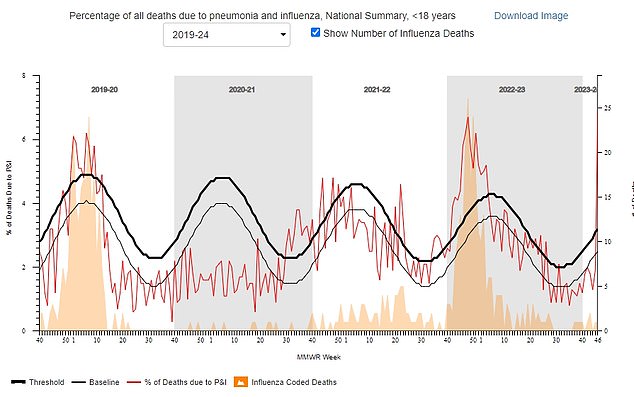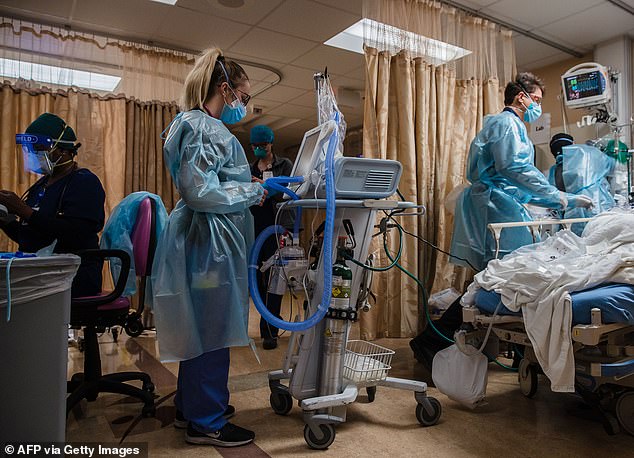What is causing the ‘white lung’ pneumonia spike in China and the US? How worried should you be? And what is mycoplasma? Everything we know about the outbreaks so far
Almost two weeks ago, news broke of an outbreak of a 'mysterious' pneumonia in China, affecting children.
While the spread began in May, the world only learned of it last week, prompting the World Health Organization to send official requests for more data to China.
Pneumonia itself is not a virus. It is used to describe any infection that inflames the lungs, whether that is a virus such as Covid or a bacteria such as streptococcus.
Data shared with the WHO and the Centers for Disease Control and Prevention showed that the rise in cases in China was not caused by a new pathogen, such as the Covid pandemic.
Testing previously shows that the cases of pneumonia are caused by several seasonal diseases, including influenza, RSV and the lesser-known mycoplasma.
The above highlights the two locations where an increase in childhood pneumonia cases has been reported in the US to date. They are Warren County, Ohio and East Longmeadow, in Massachusetts

The above graph shows deaths from pneumonia and flu among children under 18 years of age since the 2019 to 2020 flu season
Mycoplasma pneumonia is a bacterial infection that infects at least two million Americans annually but rarely makes headlines because cases are mild and deaths are extremely rare.
The difference this time is that childhood immunity is low worldwide due to lockdowns, school closures and mask mandates.
Those that locked down harder and longer, such as China, are seeing larger outbreaks, but even Sweden, which has notoriously failed to shut down its society, has recorded a rise in cases of childhood pneumonia.
Similar outbreaks of the form of pneumonia – also called 'white lung syndrome' because of the characteristic white spots on chest X-rays of affected children – have been reported in Denmark, the Netherlands and at least two US states – Ohio and Massachusetts. .
Health authorities around the world are assuring the public that the world is not on the brink of a new pandemic.
Below, DailyMail.com explains why:
What is the current situation?
The WHO has made an additional request to China for more information about its outbreak Data showed that since May, the country has seen an increasing number of children sick with mycoplasma pneumoniae – a bacterium that causes mild respiratory infections.
And in signs eerily reminiscent of Covid, Chinese officials have called for masks and social distancing.
As China continues to struggle with its own overwhelmed hospitals and children sick from school, outbreaks are starting to emerge in Europe.
On Thursday, Danish health officials said they were also dealing with an increase in the same type of pneumonia that is ravaging China.
Denmark's Statens Serum Institut (SSI) revealed that the number of cases of the disease has tripled in the past five weeks and warned that more children are likely to fall ill this winter.
That news came days after the Netherlands reported its own alarming spike in the number of children suffering from pneumonia, while a similar situation played out in Denmark's neighbor Sweden.
Meanwhile, in the US this week, doctors in Massachusetts and Ohio began reporting a spike in pneumonia cases among children, similar to the outbreak in China and parts of Europe.
In Warren County, 30 miles outside Cincinnati, 142 cases of the condition in children have been reported since August.
The state Department of Health said the situation meets the definition of an outbreak.
And in Massachusetts, doctors are seeing an increase in walking pneumonia, a mild form of the lung disease.
What's causing the spike in pneumonia cases?
The outbreaks in the US, like in China, are not caused by a new pathogen and not all cases of pneumonia are caused by the same infection.
Experts say a combination of several seasonal bacterial and viral bugs are striking at once, putting pressure on hospitals.
Many patients with respiratory symptoms test positive for a bacteria called mycoplasma pneumoniae, a pathogen that causes mild pneumonia.
Positive tests have also returned for adenovirus, a normally benign respiratory infection, and streptococcus.
Dr. Amesh Adalja, an infectious disease expert from Johns Hopkins University in Maryland, told DailyMail.com that he believes the pneumonia outbreaks emerging around the world could be due to the “cyclical” nature of mycoplasma .
Bacterial respiratory infections usually emerge every five years, normally when people are recovering from a bout of flu or other viral illnesses.
Most infections are mild, but those who have recently recovered from a respiratory infection are at greater risk.
Dr. John Kelley, of Redwood Pediatrics in East Longmeadow, Massachusetts, shared Western mass news that 80 percent of children with walking pneumonia – a mild form of pneumonia – develop the infection as a result of first having respiratory syncytial virus (RSV).
The remaining 20 percent of cases are usually attributed to bacterial infections such as mycoplasma pneumonia.

The above shows a children's hospital in California in January 2021, when hospitals across the US were hit by a wave of sick children
What is mycoplasma pneumonia?
Mycoplasma pneumonia is caused by a very small, 'atypical' bacteria called mycoplasma pneumoniae, which can lead to upper respiratory infections and pneumonia.
It causes illness by damaging the lining of the airways, including the throat, lungs and trachea, and is one of the most common causes of community-acquired pneumonia in the US.
The bacteria causes people with the lung infection to exhibit 'atypical' features, compared to people with 'typical' pneumonia caused by germs or complications of another disease.
The bacteria spreads through droplets when an infected person sneezes or coughs. It can stick in the nose and throat without making someone sick, but if it spreads to the lungs, people can develop mycoplasma pneumonia.
Although mycoplasma pneumonia is often a milder form of the lung disease – also called walking pneumonia – symptoms last longer and people with the disease do not respond to antibiotics used to treat typical pneumonia.
The Centers for Disease Control and Prevention said the number of infections varies over time and peaks every three to seven years.
An estimated two million cases of mycoplasma pneumonia occur annually, and deaths are so rare that the CDC has no firm estimate.
Why are the number of cases increasing among children?
The outbreak is hitting children the hardest because of their underdeveloped immune systems, doctors told DailyMail.com.
While adults have been exposed to common insects and diseases for decades, leading to a strengthened immunity capable of fighting colds and viruses, children build their immune systems by gradually being exposed to germs and bacteria at daycare, school , on playgrounds and on play dates.
However, because so many children around the world spent some of their formative years social distancing and wearing masks, they were not exposed to germs and their bodies could not build up resistance.
And studies have shown that children's immunity has been damaged during the pandemic due to their lack of exposure to common germs that boost the immune system against infections.
China had a much stricter and longer lockdown than other countries, under its 'zero Covid' policy, which was only officially lifted in January. first winter in years without restrictions.
Data from Chinese health officials seen by the WHO shows that pediatric cases of RSV, adenovirus, influenza and COVID-19 have increased since the fall.
Officials say the increase is not entirely unprecedented and that China would not be the first country to experience post-pandemic outbreaks.
Both Britain and the US saw a rise in other childhood illnesses after lockdowns, with respiratory diseases rising after the countries emerged.
Doctors said at the time that the spike in hospital admissions among children was “worse than any other” – as seasonal bugs returned and cases of flu and RSV reached their highest levels in more than a decade.
How concerned should you be?
Health authorities are assuring the public that the outbreak is not caused by a new or unknown virus, but is merely an increase in the normal winter virus season.
In addition, health experts also say there is no link between the outbreaks in Massachusetts and Ohio and those in China.
The CDC has said the agency doesn't see anything unusual, but is monitoring the situation closely and doctors have said it's not shocking to have an outbreak of mycoplasma pneumonia right now, given its cyclical nature.
No public or global public health emergencies have been declared and doctors are advising parents to monitor their children's health and seek medical attention if their child begins to show symptoms.
Furthermore, when children become ill, most young patients improve within a few days.
How can you protect your children?
To keep children healthy against RSV, flu, pneumonia and mycoplasma pneumonia, it is important to practice good hygiene, such as washing hands and using hand sanitizer. Covering their mouths when children sneeze or cough is also key to preventing droplets from spreading.
Wearing a mask can also help stop the spread.
Additionally, keeping sick children home from school and activities will help prevent diseases from spreading from child to child. A healthy and balanced diet, as well as adequate exercise and sleep, can help strengthen the immune system.
It is also important to be up to date on vaccinations. Vaccines are available against flu, RSV and pneumonia.
